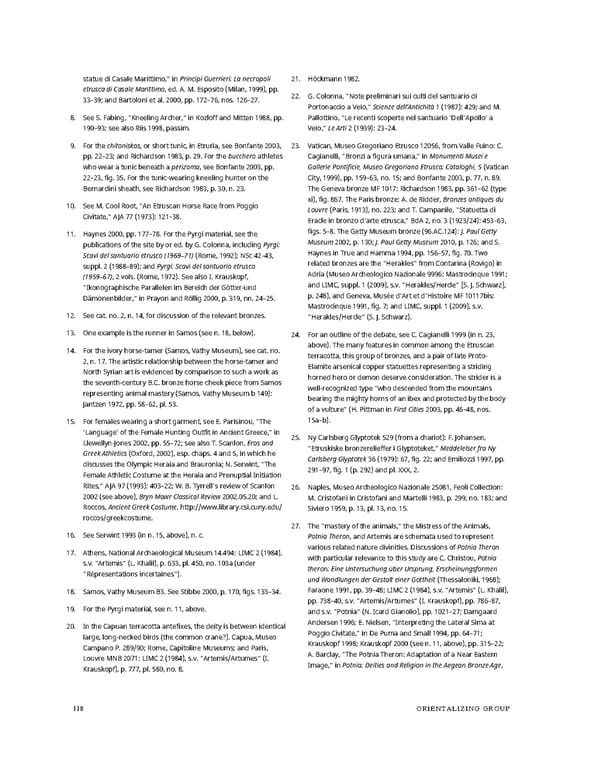statue di Casale Marittimo,” in Principi Guerrieri: La necropoli 21. Höckmann 1982. etrusca di Casale Marittimo, ed. A. M. Esposito (Milan, 1999), pp. 22. G. Colonna, “Note preliminari sui culti del santuario di 33–39; and Bartoloni et al. 2000, pp. 172–76, nos. 126–27. Portonaccio a Veio,” Scienze dell’Antichità 1 (1987): 429; and M. 8. See S. Fabing, “Kneeling Archer,” in Kozloff and Mitten 1988, pp. Pallottino, “Le recenti scoperte nel santuario ‘Dell’Apollo’ a 190–93; see also Riis 1998, passim. Veio,” Le Arti 2 (1939): 23–24. 9. For the chitoniskos, or short tunic, in Etruria, see Bonfante 2003, 23. Vatican, Museo Gregoriano Etrusco 12056, from Valle Fuino: C. pp. 22–23; and Richardson 1983, p. 29. For the bucchero athletes Cagianelli, “Bronzi a figura umana,” in Monumenti Musei e who wear a tunic beneath a perizoma, see Bonfante 2003, pp. Gallerie Pontificie, Museo Gregoriano Etrusco: Cataloghi, 5 (Vatican 22–23, fig. 35. For the tunic-wearing kneeling hunter on the City, 1999), pp. 159–63, no. 15; and Bonfante 2003, p. 77, n. 89. Bernardini sheath, see Richardson 1983, p. 30, n. 23. The Geneva bronze MF 1017: Richardson 1983, pp. 361–62 (type 10. See M. Cool Root, “An Etruscan Horse Race from Poggio xi), fig. 867. The Paris bronze: A. de Ridder, Bronzes antiques du Civitate,” AJA 77 (1973): 121–38. Louvre (Paris, 1913), no. 223; and T. Campanile, “Statuetta di Eracle in bronzo d’arte etrusca,” BdA 2, no. 3 (1923/24): 453–63, 11. Haynes 2000, pp. 177–78. For the Pyrgi material, see the figs. 5–8. The Getty Museum bronze (96.AC.124): J. Paul Getty publications of the site by or ed. by G. Colonna, including Pyrgi: Museum2002, p. 130; J. Paul Getty Museum 2010, p. 126; and S. Scavi del santuario etrusco (1969–71) (Rome, 1992); NSc 42–43, Haynes in True and Hamma 1994, pp. 156–57, fig. 70. Two suppl. 2 (1988–89); and Pyrgi: Scavi del santuario etrusco related bronzes are the “Herakles” from Contarina (Rovigo) in (1959–67), 2 vols. (Rome, 1972). See also I. Krauskopf, Adria (Museo Archeologico Nazionale 9996: Mastrocinque 1991; “Ikonographische Parallelen im Bereich der Götter-und andLIMC, suppl. 1 (2009), s.v. “Herakles/Hercle” [S. J. Schwarz], Dämonenbilder,” in Prayon and Röllig 2000, p. 319, nn. 24–25. p. 248), and Geneva, Musée d’Art et d’Histoire MF 10117bis: Mastrocinque 1991, fig. 7; and LIMC, suppl. 1 (2009), s.v. 12. See cat. no. 2, n. 14, for discussion of the relevant bronzes. “Herakles/Hercle” (S. J. Schwarz). 13. One example is the runner in Samos (see n. 18, below). 24. For an outline of the debate, see C. Cagianelli 1999 (in n. 23, 14. For the ivory horse-tamer (Samos, Vathy Museum), see cat. no. above). The many features in common among the Etruscan 2, n. 17. The artistic relationship between the horse-tamer and terracotta, this group of bronzes, and a pair of late Proto- North Syrian art is evidenced by comparison to such a work as Elamite arsenical copper statuettes representing a striding the seventh-century B.C. bronze horse cheek piece from Samos horned hero or demon deserve consideration. The strider is a representing animal mastery (Samos, Vathy Museum b 149): well-recognized type “who descended from the mountains Jantzen 1972, pp. 58–62, pl. 53. bearing the mighty horns of an ibex and protected by the body of a vulture” (H. Pittman in First Cities 2003, pp. 46–48, nos. 15. For females wearing a short garment, see E. Parisinou, “The 15a–b). ‘Language’ of the Female Hunting Outfit in Ancient Greece,” in 25. Ny Carlsberg Glyptotek 529 (from a chariot): F. Johansen, Llewellyn-Jones 2002, pp. 55–72; see also T. Scanlon, Eros and “Etruskiske bronzerelieffer i Glyptoteket,” Meddelelser fra Ny Greek Athletics (Oxford, 2002), esp. chaps. 4 and 5, in which he Carlsberg Glyptotek 36 (1979): 67, fig. 22; and Emiliozzi 1997, pp. discusses the Olympic Heraia and Brauronia; N. Serwint, “The 291–97, fig. 1 (p. 292) and pl. XXX, 2. Female Athletic Costume at the Heraia and Prenuptial Initiation Rites,” AJA 97 (1993): 403–22; W. B. Tyrrell’s review of Scanlon 26. Naples, Museo Archeologico Nazionale 25081, Feoli Collection: 2002 (see above), Bryn Mawr Classical Review 2002.05.20; and L. M. Cristofani in Cristofani and Martelli 1983, p. 299, no. 183; and Roccos, Ancient Greek Costume, http://www.library.csi.cuny.edu/ Siviero 1959, p. 13, pl. 13, no. 15. roccos/greekcostume. 27. The “mastery of the animals,” the Mistress of the Animals, 16. See Serwint 1993 (in n. 15, above), n. c. Potnia Theron, and Artemis are schemata used to represent 17. Athens, National Archaeological Museum 14.494: LIMC 2 (1984), various related nature divinities. Discussions of Potnia Theron s.v. “Artemis” (L. Khalil), p. 633, pl. 450, no. 103a (under with particular relevance to this study are C. Christou, Potnia “Répresentations incertaines”). theron: Eine Untersuchung über Ursprung, Erscheinungsformen und Wandlungen der Gestalt einer Gottheit (Thessaloniki, 1968); 18. Samos, Vathy Museum B3. See Stibbe 2000, p. 170, figs. 133–34. Faraone 1991, pp. 39–48; LIMC 2 (1984), s.v. “Artemis” (L. Khalil), pp. 738–40, s.v. “Artemis/Artumes” (I. Krauskopf), pp. 786–87, 19. For the Pyrgi material, see n. 11, above. and s.v. “Potnia” (N. Icard Gianolio), pp. 1021–27; Damgaard 20. In the Capuan terracotta antefixes, the deity is between identical Andersen 1996; E. Nielsen, “Interpreting the Lateral Sima at large, long-necked birds (the common crane?). Capua, Museo Poggio Civitate,” in De Puma and Small 1994, pp. 64–71; Campano P. 289/90; Rome, Capitoline Museums; and Paris, Krauskopf 1998; Krauskopf 2000 (see n. 11, above), pp. 315–22; Louvre MNB 2071: LIMC2 (1984), s.v. “Artemis/Artumes” (I. A. Barclay, “The Potnia Theron: Adaptation of a Near Eastern Krauskopf), p. 777, pl. 580, no. 8. Image,” in Potnia: Deities and Religion in the Aegean Bronze Age, 118 ORIENTALIZING GROUP
 Ancient Carved Ambers in the J. Paul Getty Museum Page 127 Page 129
Ancient Carved Ambers in the J. Paul Getty Museum Page 127 Page 129